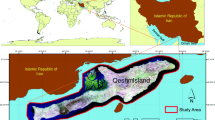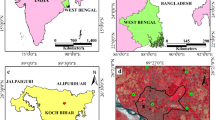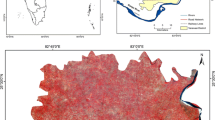Abstract
The land-use/land-cover (LU/LC) information can be extracted through continuous monitoring and observation of the global environment in the field of RS and GIS (remote sensing and geographic information system). With many inventions on satellite technologies, RS plays a crucial role throughout the world, and the researchers had shown their interest in finding the past, present, and future LU/LC information using the RS satellite data. In this research work, the non-forest- and forest-covered changes of Javadi Hills located in India were simulated and predicted using the hybrid machine learning models. The Markov chain–artificial neural network with cellular automata (MC–ANN–CA) and Markov chain–logistic regression with cellular automata (MC–LR–CA) were used and compared using the actual LU/LC maps of 2009, 2012, and 2015 along with the spatial variables (slope, aspect, hill shade, and distance road map). The results of the comparative analysis between the predicted and actual map of 2015 had shown a higher percentage of correctness in the MC–ANN–CA model for the spatial variables like slope, aspect, and distance road map. The LU/LC for 2021 and 2027 was predicted using the MC–ANN–CA model. By 2021, the forest-covered area will decrease by nearly − 0.38%, and the non-forest-covered area will increase by 0.79%. By 2027, forest-covered areas will decrease by − 0.52%, and non-forest-covered areas will increase by 1.06%, respectively, indicating the impacts of human and urbanization on LU/LC in Javadi Hills.










Similar content being viewed by others
References
Aburas, M. M., Ahamad, M. S. S., & Omar, N. Q. (2019). Spatio-temporal simulation and prediction of land-use change using conventional and machine learning models: a review. Environmental Monitoring and Assessment, 191(4), 205. https://doi.org/10.1007/s10661-019-7330-6.
Adam, E., et al. (2014). Land-use/cover classification in a heterogeneous coastal landscape using RapidEye imagery: Evaluating the performance of random forest and support vector machines classifiers. International Journal of Remote Sensing, 35(10), 3440–3458. https://doi.org/10.1080/01431161.2014.903435.
Anand, V., & Oinam, B. (2020). Future land use land cover prediction with special emphasis on urbanization and wetlands. Remote Sensing Letters, 11(3), 225–234. https://doi.org/10.1080/2150704X.2019.1704304.
Ansari, A., & Golabi, M. H. (2019). Prediction of spatial land use changes based on LCM in a GIS environment for Desert Wetlands–A case study: Meighan Wetland, Iran. International Soil and Water Conservation Research, 7(1), 64–70. https://doi.org/10.1016/j.iswcr.2018.10.001.
Arsanjani, J. J., et al. (2013). Integration of logistic regression, Markov chain and cellular automata models to simulate urban expansion. International Journal of Applied Earth Observation and Geoinformation, 21, 265–275. https://doi.org/10.1016/j.jag.2011.12.014.
Behera, N. K., & Behera, M. D. (2020). Predicting land use and land cover scenario in Indian national river basin: The Ganga. Tropical Ecology. https://doi.org/10.1007/s42965-020-00073-x.
Belgiu, M., & Dragut, L. (2016). Random forest in remote sensing: A review of applications and future directions. ISPRS Journal of Photogrammetry and Remote Sensing, 114, 24–31. https://doi.org/10.1016/j.isprsjprs.2016.01.011.
Bey, A., et al. (2016). Collect earth: Land use and land cover assessment through augmented visual interpretation. Remote Sensing, 8(10), 807. https://doi.org/10.3390/rs8100807.
Bose, A., & Chowdhury, I. R. (2020). Monitoring and modeling of spatio-temporal urban expansion and land-use/land-cover change using markov chain model: A case study in Siliguri Metropolitan area, West Bengal, India. Modeling Earth Systems and Environment, pp. 1–15.
Bounouh, O., Essid, H., & Farah, I.R. (2017). Prediction of land use/land cover change methods: A study. In 2017 international conference on advanced technologies for signal and image processing (ATSIP) (pp. 1–7). IEEE. https://doi.org/10.1109/ATSIP.2017.8075511.
Chen, L., et al. (2019). Remote Sensing for Detecting Changes of Land Use in Taipei City, Taiwan. Journal of the Indian Society of Remote Sensing, 47(11), 1847–1856. https://doi.org/10.1007/s12524-019-01031-4.
Das, P., & Pandey, V. (2019). Use of Logistic Regression in Land-Cover Classification with Moderate-Resolution Multispectral Data. Journal of the Indian Society of Remote Sensing, 47(8), 1443–1454. https://doi.org/10.1007/s12524-019-00986-8.
Dinda, S., et al. (2019). Integration of GIS and statistical approach in mapping of urban sprawl and predicting future growth in Midnapore town. India. Modeling Earth Systems and Environment, 5(1), 331–352. https://doi.org/10.1007/s40808-018-0536-8.
Eisavi, V., et al. (2015). Land cover mapping based on random forest classification of multitemporal spectral and thermal images. Environmental Monitoring and Assessment, 187(5), 291. https://doi.org/10.1007/s10661-015-4489-3.
Elagouz, M. H., et al. (2019). Detection of land use/cover change in Egyptian Nile Delta using remote sensing. The Egyptian Journal of Remote Sensing and Space Science. https://doi.org/10.1016/j.ejrs.2018.10.004.
El-Tantawi, A. M., et al. (2019). Monitoring and predicting land use/cover changes in the Aksu-Tarim River Basin, Xinjiang-China (1990–2030). Environmental Monitoring and Assessment, 191(8), 480. https://doi.org/10.1007/s10661-019-7478-0.
eSilva, L. P., et al. (2020). Modeling land cover change based on an artificial neural network for a semiarid river basin in northeastern Brazil. Global Ecology and Conservation, 21, e00811. https://doi.org/10.1016/j.gecco.2019.e00811.
Fonji, S. F., & Taff, G. N. (2014). Using satellite data to monitor land-use land-cover change in North-eastern Latvia. Springerplus, 3(1), 61. https://doi.org/10.1186/2193-1801-3-61.
Gupta, R., & Sharma, L. K. (2020). Efficacy of Spatial Land Change Modeler as a forecasting indicator for anthropogenic change dynamics over five decades: A case study of Shoolpaneshwar Wildlife Sanctuary, Gujarat. India. Ecological Indicators, 112, 106171. https://doi.org/10.1016/j.ecolind.2020.106171.
Haque, M. I., & Basak, R. (2017). Land cover change detection using GIS and remote sensing techniques: A spatio-temporal study on Tanguar Haor, Sunamganj, Bangladesh. The Egyptian Journal of Remote Sensing and Space Science, 20(2), 251–263. https://doi.org/10.1016/j.ejrs.2016.12.003.
Heidarlou, H. B., et al. (2019). Effects of preservation policy on land use changes in Iranian Northern Zagros forests. Land use policy, 81, 76–90. https://doi.org/10.1016/j.landusepol.2018.10.036.
Huang, Y., et al. (2020). Analysis of the future land cover change in Beijing using CA–Markov chain model. Environmental Earth Sciences, 79(2), 60. https://doi.org/10.1007/s12665-019-8785-z.
Islam, K., Rahman, M. F., & Jashimuddin, M. (2018). Modeling land use change using cellular automata and artificial neural network: The case of Chunati Wildlife Sanctuary, Bangladesh. Ecological Indicators, 88, 439–453. https://doi.org/10.1016/j.ecolind.2018.01.047.
Jin, Y., et al. (2018). Land-cover mapping using Random Forest classification and incorporating NDVI time-series and texture: A case study of central Shandong. International Journal of Remote Sensing, 39(23), 8703–8723. https://doi.org/10.1080/01431161.2018.1490976.
Kale, M. P., et al. (2016). Land-use and land-cover change in Western Ghats of India. Environmental Monitoring and Assessment, 188(7), 387. https://doi.org/10.1007/s10661-016-5369-1.
Kamwi, J. M. (2018). Assessing the spatial drivers of land use and land cover change in the protected and communal areas of the Zambezi Region. Namibia. Land, 7(4), 131. https://doi.org/10.3390/land7040131.
Kantakumar, L. N., & Neelamsetti, P. (2015). Multi-temporal land use classification using hybrid approach. The Egyptian Journal of Remote Sensing and Space Science, 18(2), 289–295. https://doi.org/10.1016/j.ejrs.2015.09.003.
Kavzoglu, T. (2017). Object-oriented random forest for high resolution land cover mapping using quickbird-2 imagery. In Handbook of neural computation (pp. 607–619). Academic Press. https://doi.org/10.1016/B978-0-12-811318-9.00033-8.
Khawaldah, H. A. (2016). A prediction of future land use/land cover in Amman area using GIS-based Markov Model and remote sensing. Journal of Geographic Information System, 8(03), 412. https://doi.org/10.4236/jgis.2016.83035.
Kumar, R., et al. (2014). Forest cover dynamics analysis and prediction modeling using logistic regression model. Ecological Indicators, 45, 444–455. https://doi.org/10.1016/j.ecolind.2014.05.003.
Liping, C., Yujun, S., & Saeed, S. (2018). Monitoring and predicting land use and land cover changes using remote sensing and GIS techniques—A case study of a hilly area, Jiangle, China. PloS one, https://doi.org/10.1371/journal.pone.0200493.
Lu, D., & Weng, Q. (2007). A survey of image classification methods and techniques for improving classification performance. International Journal of Remote Sensing, 28(5), 823–870. https://doi.org/10.1080/01431160600746456.
Ma, L., et al. (2019). Deep learning in remote sensing applications: A meta-analysis and review. ISPRS Journal of Photogrammetry and Remote Sensing, 152, 166–177. https://doi.org/10.1016/j.isprsjprs.2019.04.015.
Mandal, S., & Mondal, S. (2019) Logistic regression (LR) model and landslide susceptibility: A RS and GIS-based approach. In Statistical approaches for landslide susceptibility assessment and prediction, Cham: Springer (pp. 107–121). https://doi.org/10.1007/978-3-319-93897-4_4.
Mandal, S., & Mondal, S. (2019). Artificial neural network (ann) model and landslide susceptibility. In Statistical approaches for landslide susceptibility assessment and prediction. Cham: Springer, (pp. 123-133). https://doi.org/10.1007/978-3-319-93897-4_5.
Mansour, S., Al-Belushi, M., & Al-Awadhi, T. (2020). Monitoring land use and land cover changes in the mountainous cities of Oman using GIS and CA-Markov modelling techniques. Land Use Policy, 91, 104414. https://doi.org/10.1016/j.landusepol.2019.104414.
Mishra, V. N., & Rai, P. K. (2016). A remote sensing aided multi-layer perceptron-Markov chain analysis for land use and land cover change prediction in Patna district (Bihar), India. Arabian Journal of Geosciences, 9(4), 249. https://doi.org/10.1007/s12517-015-2138-3.
Misra, A., & Vethamony, P. (2015). Assessment of the land use/land cover (LU/LC) and mangrove changes along the Mandovi-Zuari estuarine complex of Goa, India. Arabian Journal of Geosciences, 8(1), 267–279. https://doi.org/10.1007/s12517-013-1220-y.
Mohajane, M., et al. (2018). Land use/land cover (LULC) using Landsat data series (MSS, TM, ETM + and OLI) in Azrou Forest, in the Central Middle Atlas of Morocco. Environments, 5(12), 131. https://doi.org/10.3390/environments5120131.
MohanRajan, S. N., Loganathan, A., & Manoharan, P. (2020). Survey on land use/land cover (LU/LC) change analysis in remote sensing and GIS environment: Techniques and challenges. Environmental Science and Pollution Research, 27, 29900–29926. https://doi.org/10.1007/s11356-020-09091-7.
Mondal, S., & Mandal, S. (2018). RS & GIS-based landslide susceptibility mapping of the Balason River basin, Darjeeling Himalaya, using logistic regression (LR) model. Georisk: Assessment and Management of Risk for Engineered Systems and Geohazards 12(1), 29–44. https://doi.org/10.1080/17499518.2017.1347949.
Munthali, M. G., et al. (2020). Modelling land use and land cover dynamics of Dedza district of Malawi using hybrid Cellular Automata and Markov model. Remote Sensing Applications: Society and Environment, 17, 100276. https://doi.org/10.1016/j.rsase.2019.100276.
Navin, M. S., & Agilandeeswari, L. (2019). Land use land cover change detection using k-means clustering and maximum likelihood classification method in the Javadi Hills, Tamil Nadu, India. International Journal of Engineering and Advanced Technology (IJEAT). https://doi.org/10.35940/ijeat.A1011.1291S319.
Navin, M. S., & Agilandeeswari, L. (2020). Comprehensive review on land use/land cover change classification in remote sensing. Journal of Spectral Imaging. https://doi.org/10.1255/jsi.2020.a8.
Nurwanda, A., & Honjo, T. (2020). The prediction of city expansion and land surface temperature in Bogor City, Indonesia. Sustainable Cities and Society, 52, 101772. https://doi.org/10.1016/j.scs.2019.101772.
Odindi, J. O., et al. (2014). Comparison between WorldView-2 and SPOT-5 images in mapping the bracken fern using the random forest algorithm. Journal of Applied Remote Sensing, 8(1), 083527. https://doi.org/10.1117/1.JRS.8.083527.
Pandey, P., Dewangan, K. K., & Dewangan, D. K. (2017). Enhancing the quality of satellite images by preprocessing and contrast enhancement. In 2017 international conference on communication and signal processing (ICCSP) (pp. 0056–0060). IEEE. https://doi.org/10.1109/ICCSP.2017.8286525.
Pimple, U., et al. (2017). Topographic correction of Landsat TM-5 and Landsat OLI-8 imagery to improve the performance of forest classification in the mountainous terrain of Northeast Thailand. Sustainability, 9(2), 258. https://doi.org/10.3390/su9020258.
Poor, E. E., Shao, Y., & Kelly, M. J. (2019). Mapping and predicting forest loss in a Sumatran tiger landscape from 2002 to 2050. Journal of Environmental Management, 231, 397–404. https://doi.org/10.1016/j.jenvman.2018.10.065.
Qiang, Y., & Lam, N. S. (2015). Modeling land use and land cover changes in a vulnerable coastal region using artificial neural networks and cellular automata. Environmental Monitoring and Assessment, 187(3), 57. https://doi.org/10.1007/s10661-015-4298-8.
Reddy, C. S., et al. (2017). Predictive modelling of the spatial pattern of past and future forest cover changes in India. Journal of Earth System Science, 126(1), 8. https://doi.org/10.1007/s12040-016-0786-7.
Rwanga, S. S., & Ndambuki, J. M. (2017). Accuracy assessment of land use/land cover classification using remote sensing and GIS. International Journal of Geosciences, 8(04), 611. https://doi.org/10.4236/ijg.2017.84033.
Saputra, M. H., & Lee, H. S. (2019). Prediction of land use and land cover changes for North Sumatra, Indonesia, using an artificial-neural-network-based cellular automaton. Sustainability, 11(11), 3024. https://doi.org/10.3390/su11113024.
Satya, B. A., Shashi, M., & Deva, P. (2020). Future land use land cover scenario simulation using open source GIS for the city of Warangal, Telangana, India. Applied Geomatics. https://doi.org/10.1007/s12518-020-00298-4.
Sawant, S. S., & Prabukumar, M. (2018). A review on graph-based semi-supervised learning methods for hyperspectral image classification. The Egyptian Journal of Remote Sensing and Space Science. https://doi.org/10.1016/j.ejrs.2018.11.001.
Sawant, S. S., & Prabukumar, M. (2020). A survey of band selection techniques for hyperspectral image classification. Journal of Spectral Imaging. https://doi.org/10.1255/jsi.2020.a5.
Siddiqui, A., et al. (2018). Urban growth dynamics of an Indian metropolitan using CA Markov and Logistic Regression. The Egyptian Journal of Remote Sensing and Space Science, 21(3), 229–236. https://doi.org/10.1016/j.ejrs.2017.11.006.
Singh, S. K., et al. (2015). Predicting spatial and decadal LULC changes through cellular automata Markov chain models using earth observation datasets and geo-information. Environmental Processes, 2(1), 61–78. https://doi.org/10.1007/s40710-015-0062-x.
Singh, S. K., et al. (2018). Modelling of land use land cover change using earth observation data-sets of Tons River Basin, Madhya Pradesh, India. Geocarto international, 33(11), 1202–1222. https://doi.org/10.1080/10106049.2017.1343390.
Somvanshi, S. S., et al. (2020). Monitoring spatial LULC changes and its growth prediction based on statistical models and earth observation datasets of Gautam Budh Nagar, Uttar Pradesh, India. Environment, Development and Sustainability, 22(2), 1073–1091. https://doi.org/10.1007/s10668-018-0234-8.
Taufik, A., Ahmad, S. S. S., & Azmi, E. F. (2019). classification of landsat 8 satellite data using unsupervised methods. In Intelligent and interactive computing (pp. 275–284). Singapore: Springer. https://doi.org/10.1007/978-981-13-6031-2_46.
Tavangar, Sh, et al. (2019). A futuristic survey of the effects of LU/LC change on streamflow by CA–Markov model: A case of the Nekarood watershed, Iran. Geocarto International, 2019, 1–17. https://doi.org/10.1080/10106049.2019.1633419.
Tavares, P. A., et al. (2019). Integration of sentinel-1 and sentinel-2 for classification and LULC mapping in the urban area of Belém, eastern Brazilian Amazon. Sensors, 19(5), 1140. https://doi.org/10.3390/s19051140.
Thyagharajan, K. K., & Vignesh, T. (2019). Soft computing techniques for land use and land cover monitoring with multispectral remote sensing images: A review. Archives of Computational Methods in Engineering, 26(2), 275–301. https://doi.org/10.1007/s11831-017-9239-y.
Tilahun, A., & Teferie, B. (2015). Accuracy assessment of land use land cover classification using Google Earth. American Journal of Environmental Protection, 4(4), 193–198. https://doi.org/10.11648/j.ajep.20150404.14.
Yatoo, S. A., et al. (2020). Monitoring land use changes and its future prospects using cellular automata simulation and artificial neural network for Ahmedabad city, India. GeoJournal. https://doi.org/10.1007/s10708-020-10274-5.
Yirsaw, E. (2017). Land use/land cover change modeling and the prediction of subsequent changes in ecosystem service values in a coastal area of China, the Su-Xi-Chang Region. Sustainability, 9(7), 1204. https://doi.org/10.3390/su9071204.
Zhu, Z. (2017). Change detection using landsat time series: A review of frequencies, preprocessing, algorithms, and applications. ISPRS Journal of Photogrammetry and Remote Sensing, 130, 370–384. https://doi.org/10.1016/j.isprsjprs.2017.06.013.
Acknowledgements
Authors wish to thank Bhuvan Indian Geo-Platform of ISRO for freely providing the LISS–III data and Cartosat-1 DEM data for study area Javadi Hills, Tamil Nadu, India. We are thankful to the Google Earth Engine platform for providing the map of Javadi Hills. We wish to thank DIVA-GIS and ArcGIS geospatial software for preparing the shapefile of the India Map. We are thankful to the Vellore Institute of Technology for providing the VIT SEED GRANT for carrying out this work and CDMM (Centre for Disaster Mitigation & Management) for providing a good lab facility.
Author information
Authors and Affiliations
Corresponding author
Additional information
Publisher's Note
Springer Nature remains neutral with regard to jurisdictional claims in published maps and institutional affiliations.
About this article
Cite this article
MohanRajan, S.N., Loganathan, A. Modelling Spatial Drivers for LU/LC Change Prediction Using Hybrid Machine Learning Methods in Javadi Hills, Tamil Nadu, India. J Indian Soc Remote Sens 49, 913–934 (2021). https://doi.org/10.1007/s12524-020-01258-6
Received:
Accepted:
Published:
Issue Date:
DOI: https://doi.org/10.1007/s12524-020-01258-6




